




The Warm Heart biochar program is proving to be an effective tool in fighting Thailand’s smoke problem. The more biochar farmers make, the less crop waste is burned in the fields, and the less our skies are darkened with PM2.5 haze.
If we want to solve this problem in the long-term, however, we need to do more than just deal with the staggering amounts of crop waste created every year.
What do we need to do?
We need to stop this waste from being created in the first place.
Our Agroforestry Program helps farmers move to more environmentally-friendly, safer, and more profitable methods of farming that don’t generate crop waste.
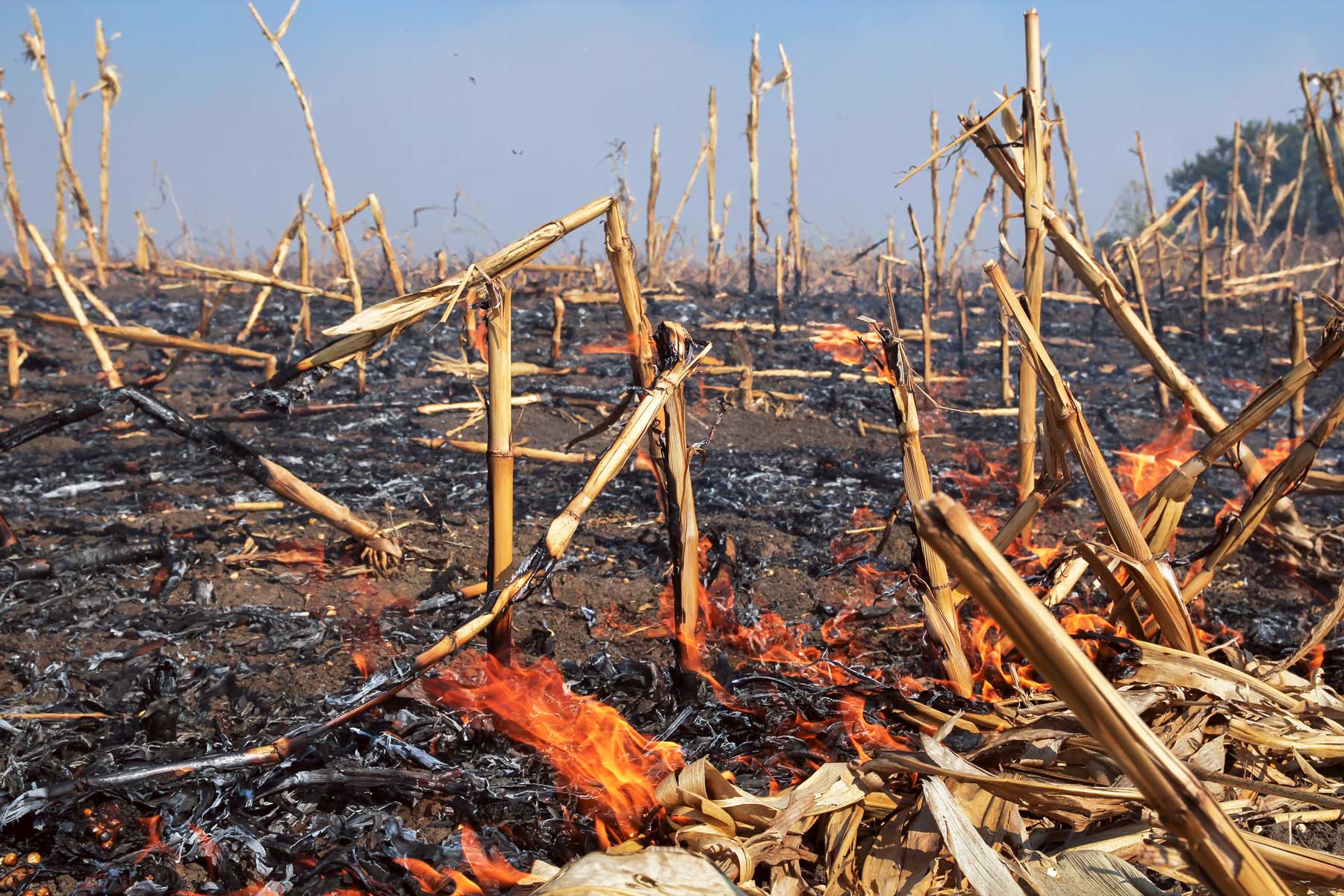
With a bit of help, farmers can end their reliance on “high-waste” crops such as corn and sugarcane, by replanting diverse forests full of high-value, no-waste crops.
The benefits could be huge.
Thailand’s skies would clear. Farmers’ incomes would rise. Massive areas of deforested nature would be repaired. Biodiversity would recover, as habitats are restored. Steams that now run dry in March would once again run all year around. Rather than rapidly running off and flooding Bangkok annually, rain water would be held in Northern farmers’ fields.
To understand just how important this is, let’s look at how we got to where we are now.
There are many causes for this smoke crisis – such as forest fires, mushroom foraging, vehicle exhausts, and weather patterns – but one of the most significant sources is agricultural crop waste burning.
This burning happens when farmers grow crops that generate a lot of bio-waste, such as rice, sugarcane, and corn.
Only a small percentage of these plants can be harvested and used, generating huge amounts of crop waste in the form of stubble, sugarcane leaves, corn cobs, husks and stalks. This crop waste must be cleared either before harvesting (sugarcane) or after (rice and corn), to clear fields for planting the next season.
At Warm Heart we are especially focused on the problems caused by corn, as it is the main culprit in much of Northern Thailand with 5.5 million tonnes grown here annually.
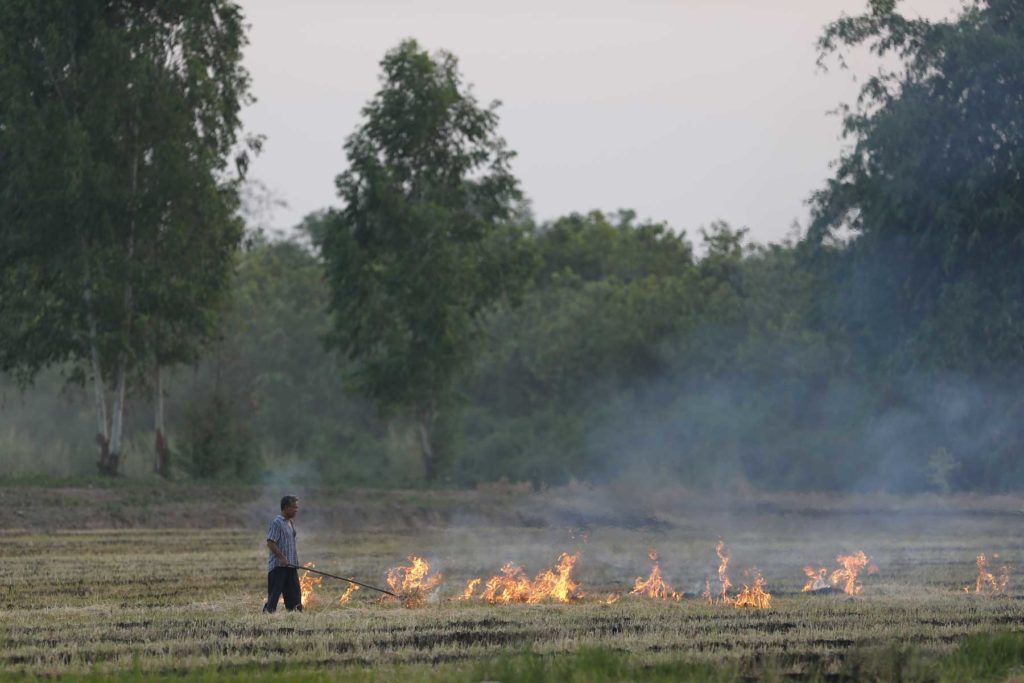
Corn is a very hardy plant that will grow nearly anywhere, under almost any conditions.
It is one of the few crops that will thrive in Northern Thailand, where soils are notoriously bad, rains fall only 3 months a year, and farms are small and remote.
Dried corn kernel is virtually indestructible and requires no special handling. It can easily be stored and transported, even along the dirt paths that connect many farms to the markets. Demand is solid as the demand for meat and milk keeps soaring (most corn is not grown for human consumption, but for animal feed).
No wonder that poor farmers around the world have burned vast forests to plant corn. Whatever the real value of the forests, the land is worthless in the market, inviting the large-scale production of cheap corn.
The result looks like this:
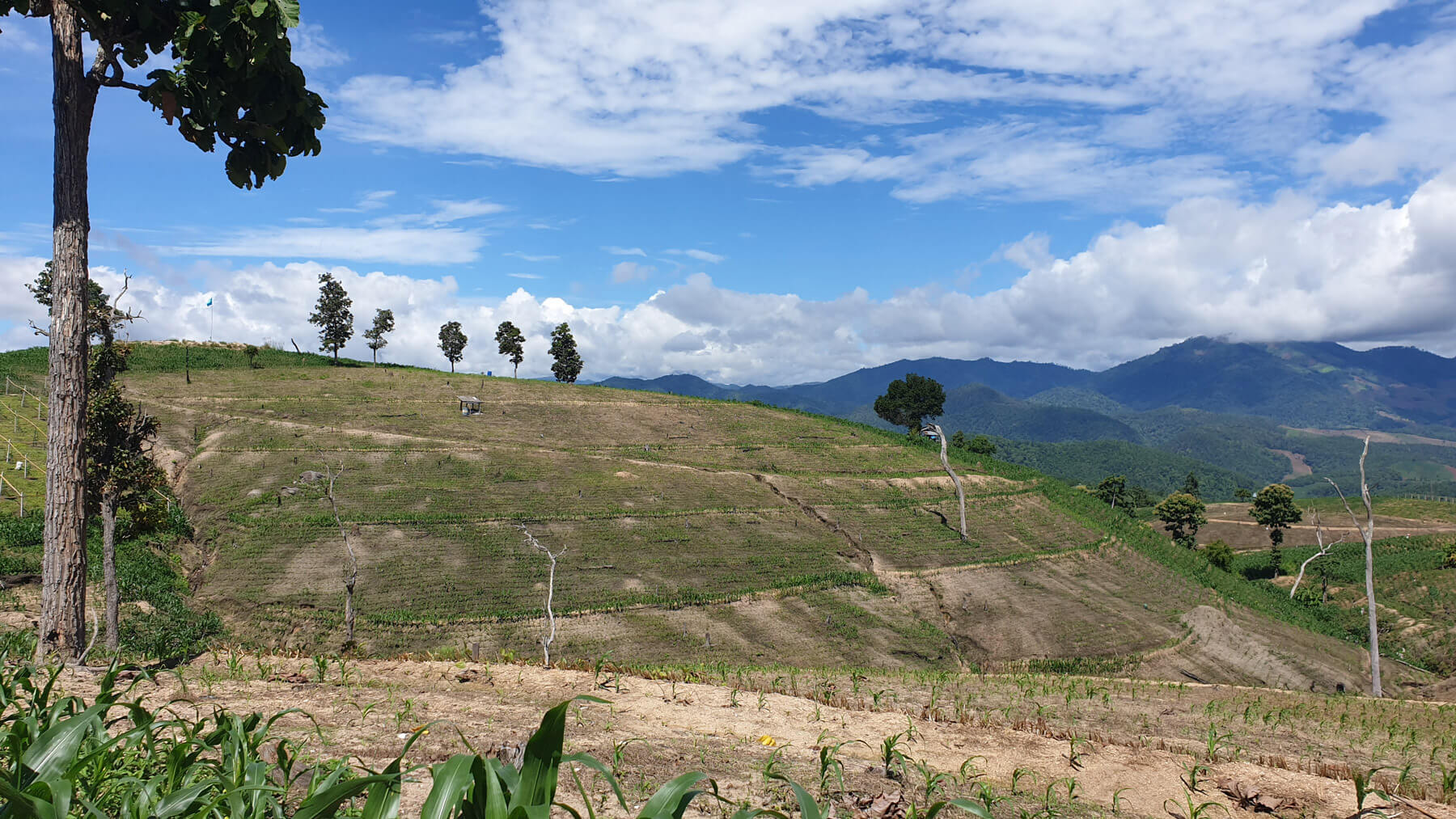
Corn is also a particularly dirty crop. Some crops produce only as much waste as they do food. Corn, on the other hand, produces just ~20% edible kernels. The remaining ~80% of the crop is inedible waste – stalk, cobs, and husk.
For every 1kg of edible corn kernels grown, ~3.5kg of crop waste is generated that must be cleared from the field before the next year’s crop can be grown.
This isn’t a problem in developed nations where fields are large and flat, and farmers can afford tractors to turn waste under.
Poor farmers, however, cannot afford tractors, and their fields are neither large nor flat. They often look more like this:
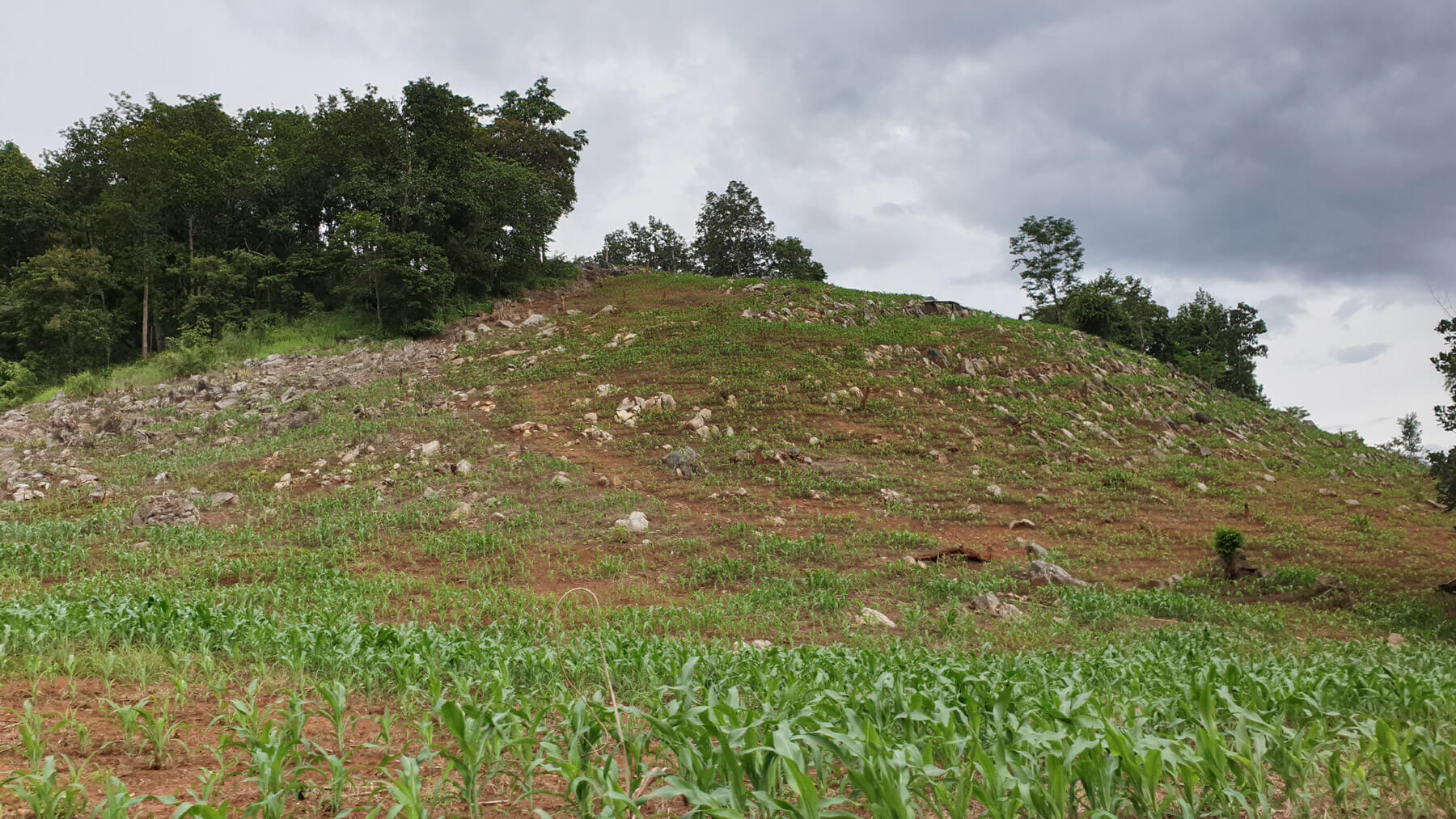
Clearing these fields by hand would take weeks of work in brutal heat (43⁰C/105⁰ F) without pay – and without anything to do with the waste once collected. The meager income farmers earn from farming is barely enough to make ends meet as is. They can’t afford to spend weeks clearing fields by hand, when they have other work that needs doing.
What is a poor farmer’s best alternative? Fire. It is cheap, fast, thorough – and largely effortless.
And so each year, farmers set vast mountains of crop waste on fire, creating huge plumes of smoke and deadly PM2.5 that plague millions of people in the region.
In addition to the PM2.5 pollution, the large-scale cultivation of corn has also created a number of devastating local environmental problems.
Huge areas of forests have been cleared to make room for growing corn. Biodiversity has suffered as animal and bird habitats are destroyed.
Soils have become depleted. They absorb less and less rainwater, as forest trees that once allowed water to penetrate the soil are removed. Corn is planted thinly and – unlike the trees it replaces – provides no protection for the soil, which becomes brick hard when wetted and sun dried.
This has destroyed watersheds, as the rainwater that once soaked into the ground now runs off rapidly, eroding fields and causing flooding downstream in the Center and South of Thailand.

So what is a farmer to do with crop waste?
And what are we to do about the destruction of forests, habitat, biodiversity and watershed, and the huge increase in flood waters being experienced in the Center and South of Thailand?
Making biochar is the best solution that we know of short-term.
Biochar gives farmers an alternative to burning their crop waste. It gives them a profit incentive not to burn but instead to turn their crop waste into a valuable product that makes them extra income when there is no work.
The demand for biochar in Thailand is limited, however, and the potential supply immense. It will take a lot of time and money to create a big enough market to absorb all of the biochar, probably too long and too much money for a single, small NGO.

Warm Heart is, therefore, looking to the long-term. We seek both to reduce the total amount of crop waste that might be burned and to restore the forests, habitats, biodiversity and watersheds destroyed when the great forests were cleared to make way for corn fields.
Warm Heart believes that the long-term solution to the climate, environmental and public health threats posed by current agricultural practices in the North, and the long-term, sustainable solution to rural poverty is agroforestry – a way of farming that restores forests while growing a diverse selection of crops in the forest shade.
An understanding of agroforestry starts with a basic understanding of plants and crops.
Virtually all plants fall into one of two categories: annuals and perennials.
Annual crops are “single season” crops like corn or rice that go from seed to harvest in one growing season. After harvesting, the plant dies off, and this plant biomass must be cleared from fields before the next season’s crops can be grown.
Perennial crops grow for many years. Trees fall into this category, as do many other higher value crops like cacao, coffee, bamboo, fruits, nuts, and herbs. Because these plants don’t die off after harvesting, they generate little crop waste.
If we can help farmers grow more perennial plants rather than annuals, we can cut the amount of crop waste that gets burned every year and reduce farmers’ dependence on a single crop/source of income.
To be clear: it’s isn’t practical (or desirable) to replace all corn with perennial crops.
The demand for animal feed is strong, so corn isn’t going anywhere. Instead, the goal is to replace corn grown in difficult conditions – mountain tops, steep inclines, and other areas where it can’t easily be cleared and turned to biochar – while restoring forests and all that they contribute.
So how can this be achieved?
Let’s take a look.
In the simplest terms, agroforestry can be thought of as “agriculture with trees”.
It’s a more environmentally-friendly system, in which crops are interplanted with trees and shrubs. Some of these trees grow fruits or nuts that can be harvested. Others grow for many years, and can later be harvested for timber. And some trees aren’t grown for harvesting, but rather for the many other important benefits they provide: improving soil quality, preserving biodiversity, and creating shade and protection for more delicate crops.
In the shade of these trees, farmers can plant cash crops such as coffee, cacao, rattan, tea, Thai black pepper and many others. They can grow local fruits that have disappeared from local markets, and plant family vegetable gardens around the perimeter that provide food year round and excess to sell while waiting for the perennials to yield.
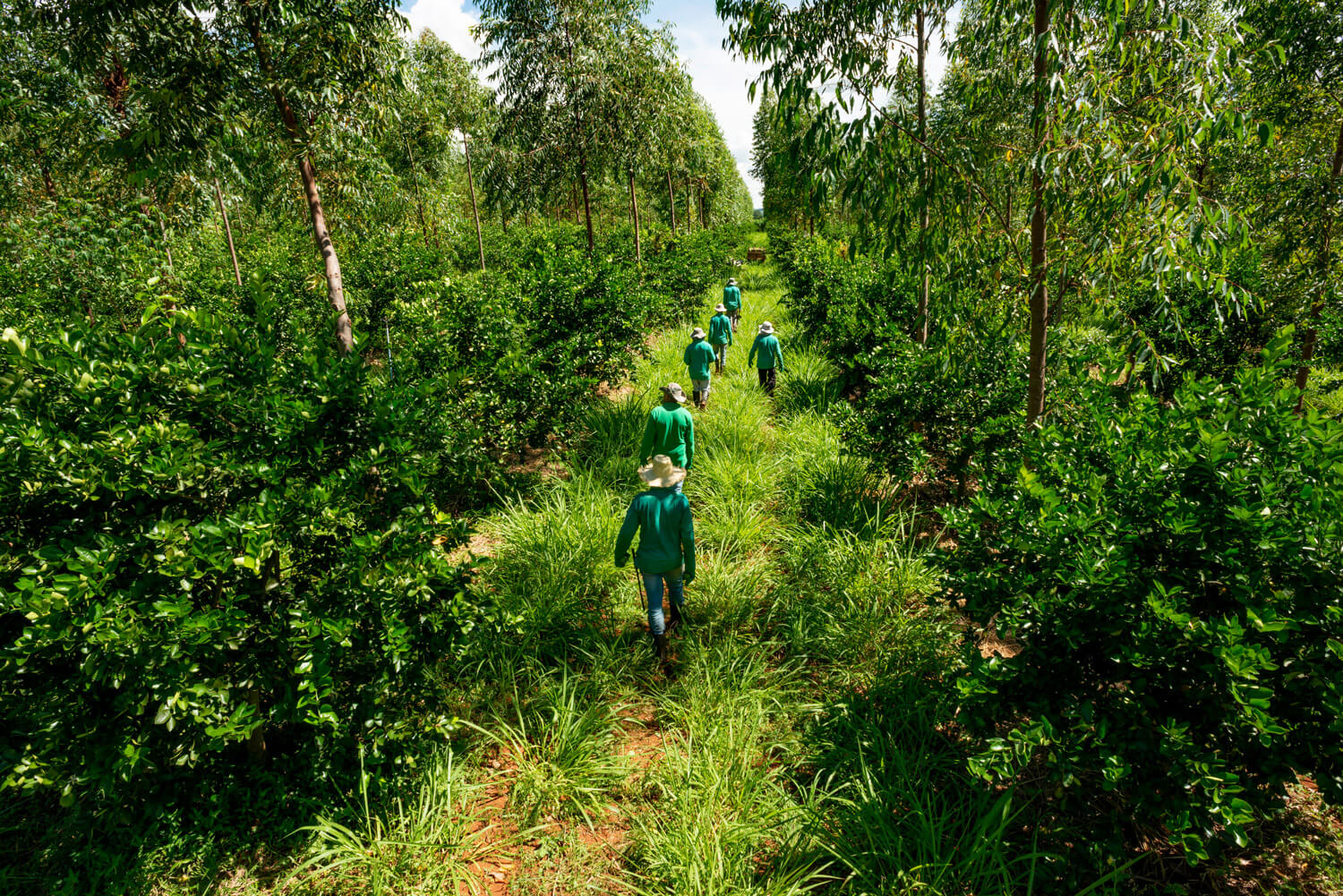
The widespread adoption of agroforestry in Northern Thailand is not only key to fighting the smoke problem, but could also provide countless other benefits by protecting Thailand’s forests, animals and birds, and mitigating climate change.
Here is an opportunity for Thailand to lead the way!
If the benefits really are so large, why aren’t all farmers doing this already?
The simple answer: a lack of money and expertise to get started.
The longer answer: there are a handful of challenges that need to be overcome, namely:
Northern Thailand is subject to a “dry/hot season” from Nov-May, which sees little to no rain. This isn’t an issue for annual crops like corn – it doesn’t matter that the rains stop after harvest, because the plants dies off anyway. This is not, of course, the situation with agroforestry.
How to supply sufficient water during the dry season?
There are a few options:
1. Install a plastic-lined pond. Farmers can install ponds at the top of their hills to collect water throughout the rainy season, so it can be used during the dry season. Installing a plastic-lined pond is the fastest method for storing water, but also the most expensive. It is also likely to only last 5-10 years, and generates significant plastic waste once replaced.
2. Create an organically-lined pond. Rather than using a plastic lining, ponds can be sealed using compacted layers of organic materials, such as manure and banana leaf. As microbes digest this material over time, they create an organic film that cover the pond floor and seals it, in a process known as gleization. While this method is more durable and environmentally friendly, it can take 3-5 years for the film to become strong enough to hold water year-round.
3. Heavy Duty Soil Regeneration. The third option is to increase the amount of water that the soil can hold, by adding organic matter. Though this happens naturally when land is left to reforest, this process can take many years, especially once soil has been stripped of all vegetation. One way to kick-start this process is to mix large amounts of biochar and compost into the ground, an approach that Warm Heart is trialing (more on that in a minute).
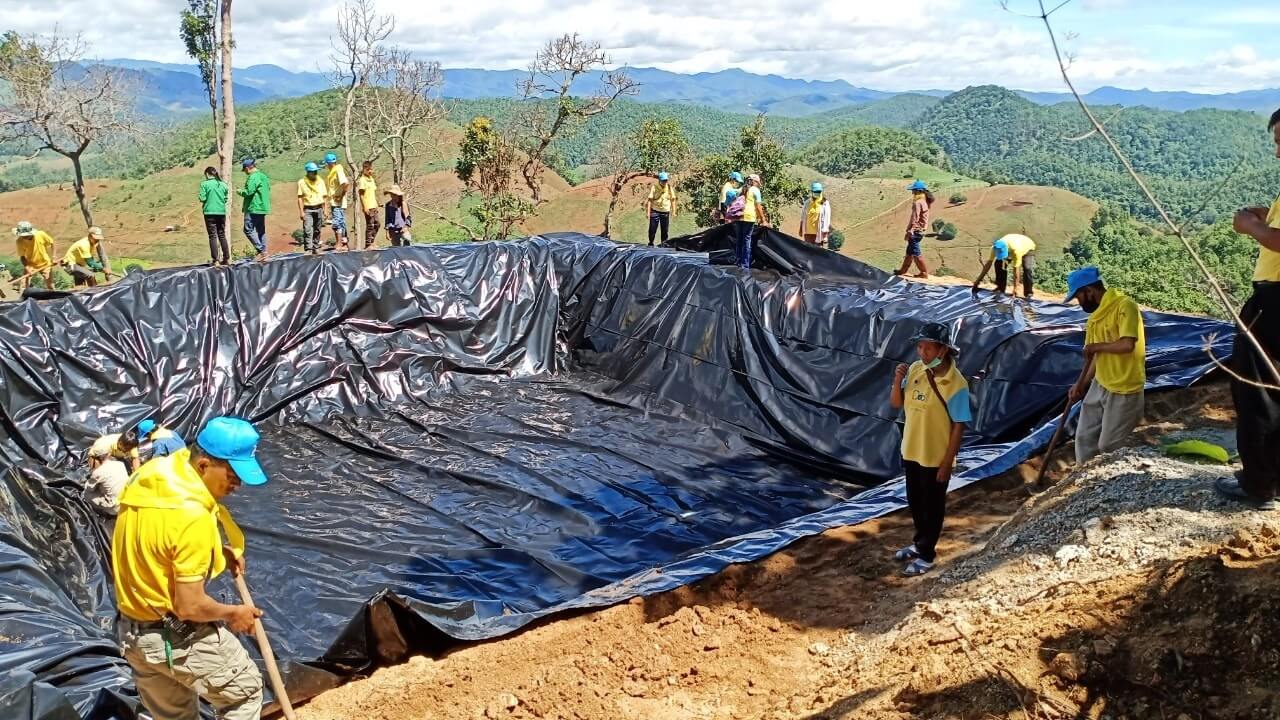
Regardless of the method, these systems do not come cheap, and money is in short supply for these farmers.
Which brings us to our next challenge:
While agroforestry can be far more profitable in the long run, farmers have up-front costs when setting up these systems.
Expensive watering systems may need to be installed. New trees and crops need to be purchased and planted. And crucially, the soil must be restored to a level that will allow these new trees and crops to grow.
Many of these farmers own fields which slope steeply down from “bald” mountain tops – mountains that used to be covered in forest, but have been cleared for growing corn. The soil on these fields is just dirt, with no organic matter and no capacity to retain water. Without forest above, no water infiltrates into the soil. When it rains, it simply washes down the mountain slope, taking any remaining topsoil with it.
The immediate solution is to turn tonnes – literally tonnes – of biochar-based compost into the soil. The organic material in the compost will retain water until it decomposes. The biochar will retain water forever.
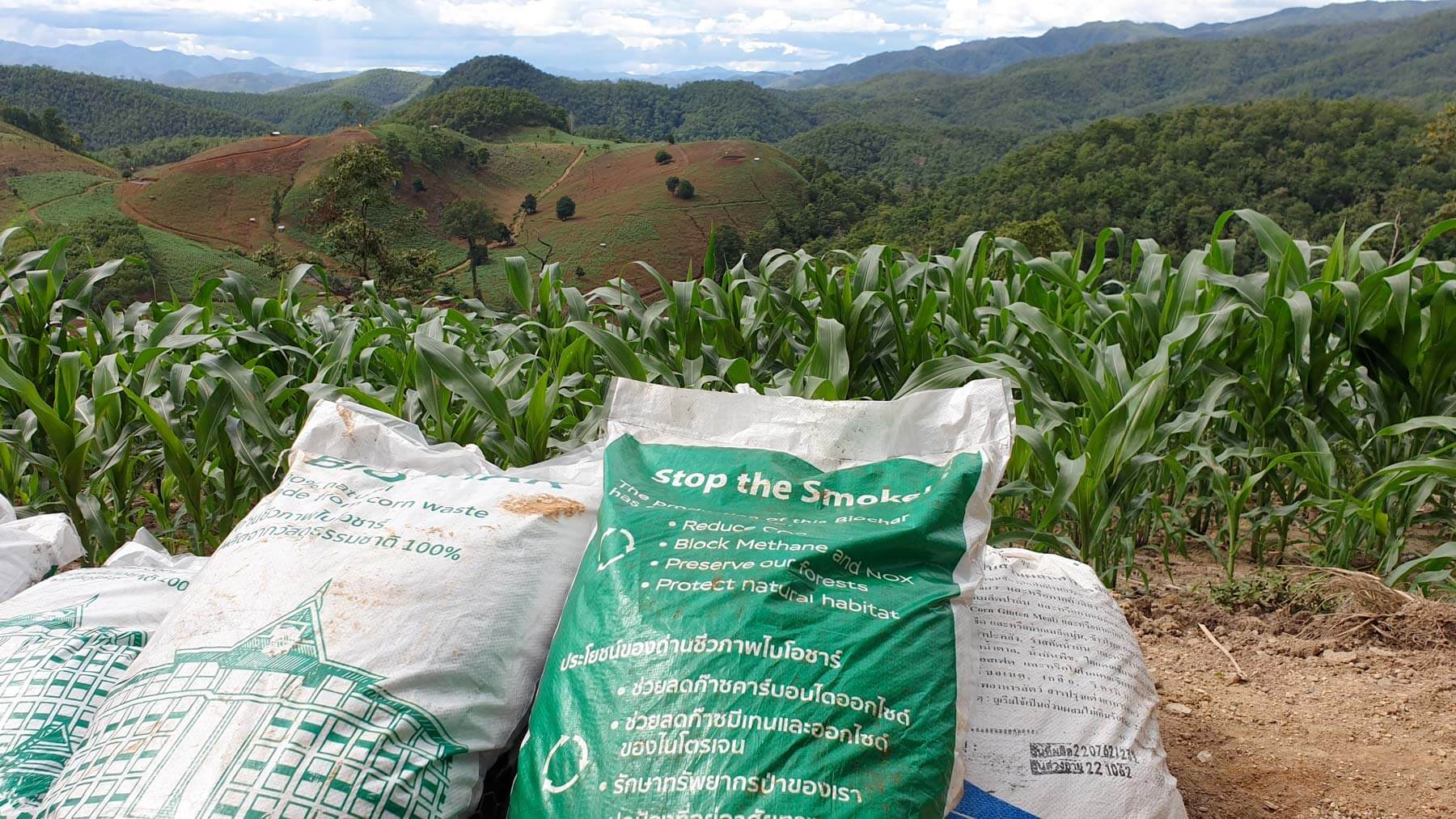
At a rate of 1 kg of biochar per square meter, even a farm with North Thailand’s soil should retain sufficient water to get through the dry season. If forest trees, coffee, tea and cocoa bushes are planted in the top portion of the field, water penetration and retention will rise as well.
All this costs money, however: money for the biochar, money to make the compost, money to deliver biochar and compost, money for labor. Money, money, money.
Agroforestry will be safe and profitable in a few years, but how is a poor farmer to get started?
Credit, of course.
But not so quick.
What do you need to get a loan?
Collateral. Something that the bank can take if you don’t pay.
Problem: Most small farmers do not own their land. They cannot collateralize it. So the very first and very real problem that small farmers face is: how to pay for alternatives to growing corn?
Warm Heart is still working hard on this problem. We have found no solutions yet that can be scaled up. All we can observe is that the farmers who have self-selected to partner with us all have second incomes and appear to be much better off than the average Northern farmer.
As a Foundation, our property, too, is worthless as collateral. Perhaps generous Thai donors, corporations, maybe even a bank will step up to guarantee farmers’ loans.
For now, this remains a major piece of the puzzle that must be solved.
When Warm Heart began discussing agroforestry with local farmers, many expressed concern than if they made the move, they would not have anything to eat for the first few years.
Perennial crops take time to mature, often many years. Once they have, they can make a farmer more money than corn. But what about the time before they mature? As these farmers point out regularly, they don’t have much money to burn.
So, we suggest, there are things they can do. If they prepare their soil well, they will be able to grow even more corn than before, despite having to work around the new trees. We teach them how they can plant gardens to provide food year round, so that they do not need to buy food. And, if worst comes to worst, Warm Heart will guarantee a minimum income for the first three years.
It’s one thing to grow corn, the fail-safe crop. It’s another to grow a dozen different crops that require harvesting at different times, different fertilizing schedules, and different kinds of care. And at the edge of the developed world, this knowledge does not grow on trees, so to speak.
Biodiversity is the key to making an agroforestry system work. Plants rely on symbiotic relationships with other plants, insects, and animals. Farmers must learn to think in terms of systems, rather than individual crops.
How is a farmer to learn all of this?
That’s a big part of Warm Heart’s job. We help connect farmers with agroforestry experts who have experience setting up these systems. Together, they can plan and manage farms that are custom tailored to each farmer’s terrain and needs.
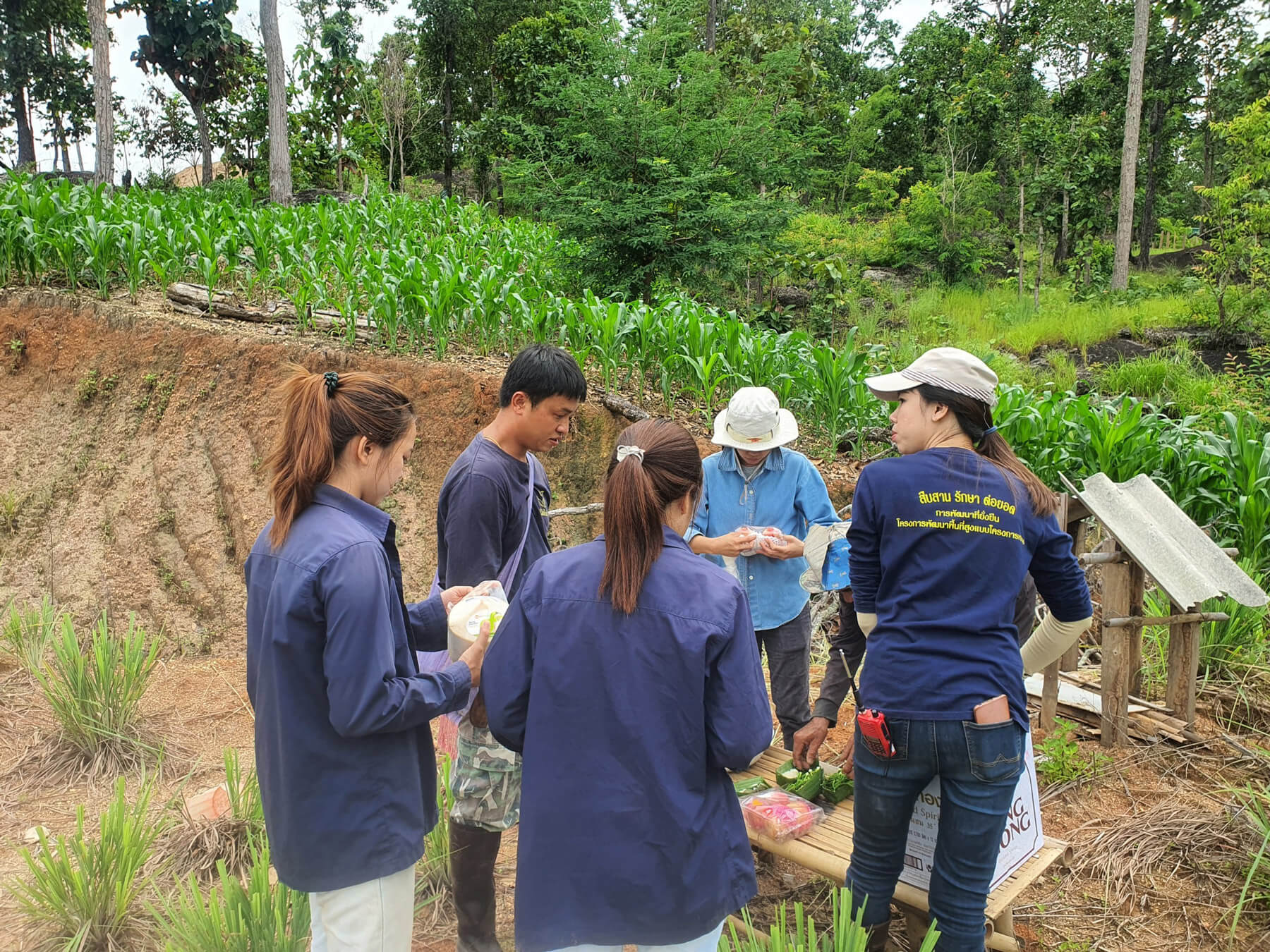
Most soils in the tropics are difficult to work with: they are acidic, low in nutrients, and poor at absorbing and retaining water. They lack organic carbon and, importantly, soil life.
Decades of mono-cropping, uninformed synthetic fertilizer and pesticide use, deforestation and the exposure of unplanted ground to the sun have further degraded these already marginal soils.
Corn grows in this stuff, but few other things will.
This is where Warm Heart’s biochar program really shines. Even the simplest biochar made by the poorest farmer using the lowest-tech equipment will:
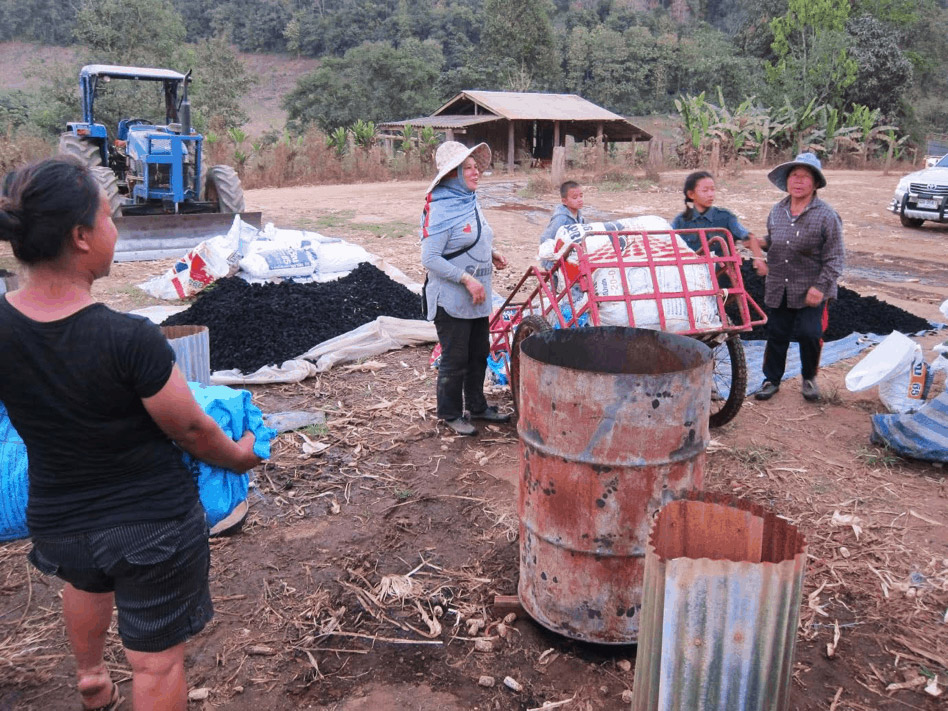
Hundreds of scientific studies prove that biochar is especially effective at improving depleted tropical soils, a phenomena we have seen many times with our own eyes.
Fortunately, we have plenty of biochar that we can provide to farmers at low or no cost to improve their soils and allow them to grow plants which otherwise wouldn’t be possible. We also teach farmers how to make their own.
We partner with farmers to help overcome the challenges listed above in the following ways:
To make it possible for those without proper documents to borrow
To reduce farmers’ fear of failure for the first 3 years while new plants mature
Connect farmers with experts to create systems that work for their land
To improve the land and ensure sufficient water
Burning season is upon us, and we are in urgent need of funds to prevent as much smoke as we can!
No matter how old you are, where you live, or what you can give, you can help end the smoke crisis—and you can start right now!
Please make a difference by contributing today:
Stop the Smoke is an initiative by Warm Heart, a grassroots organization that helps Thai villagers in the remote northern district of Phrao, Chiang Mai Province.
We organize community projects that provide access to improved education and basic health services, create jobs and sustainable incomes for the poorest in our community, and restore the environment so it will sustain future generations.





Copyright © 2021 Warm Heart Worldwide | Registered 501(c)(3). EIN: 26-2059241